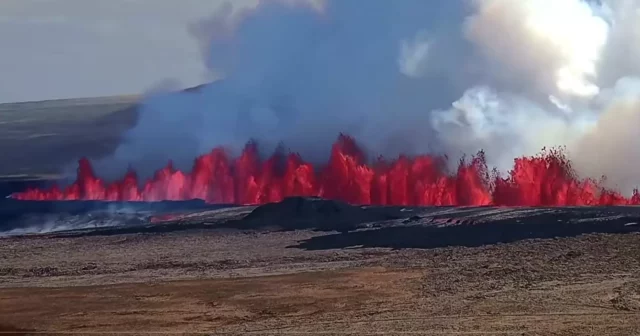Earthquake and Volcanic Eruption in Iceland
Recently, Iceland experienced a significant seismic event that led to a volcanic eruption on the Reykjanes Peninsula. This seismic activity is particularly noteworthy as it marks the fifth volcanic eruption in this region since the last winter. The epicenter of the earthquake was identified just north of the charming fishing town of Grindavik, stirring both concern and fascination among locals and tourists alike.
Evacuation and Impact
In the aftermath of the earthquake, the situation escalated quickly, resulting in the eruption compelling local authorities to implement evacuation protocols. Approximately 3,800 residents of Grindavik, as well as visitors from the famous Blue Lagoon thermal resort, were instructed to leave the area. Eyewitness accounts vividly describe the scene: lava spewing from the volcano reaching heights of about 50 meters, creating an awe-inspiring yet terrifying spectacle.
This recent activity isn’t an isolated incident. The Reykjanes Peninsula has seen volcanic eruptions earlier this year, with notable occurrences in January and March that were similarly accompanied by earthquakes. Such recurring geological events highlight the dynamic nature of this region and underscore the importance of preparedness.
The Importance of Preparedness
So, why should we pay attention to these volcanic eruptions? Beyond their mesmerizing beauty, they serve as a stark reminder of nature’s power. For residents in geologically active areas, understanding evacuation protocols can save lives. For instance, during the earlier eruptions, rapid response and efficient evacuation saved countless lives, as residents were ready and informed about escape routes and safety measures.
- Education: The local government often holds educational sessions for residents about how to respond in the event of an eruption.
- Emergency Kits: Keeping an emergency kit stocked with essentials like water, food supplies, and first-aid provisions is crucial. Consider including items specific to your family’s needs.
- Community Drills: Participating in community evacuation drills can ensure everyone knows the safest routes and protocols during a crisis.
Understanding the Risks
Statistic shows that approximately 10% of all volcanic eruptions occur in Iceland, making it one of the most volcanically active regions on Earth. These eruptions can bring forth significant geological and social challenges, including potential displacement and economic repercussions for local communities. The effects of such natural disasters extend beyond the immediate, impacting tourism, agriculture, and local economies.
Moreover, depending on the scale of the eruption, the ash and smoke can affect air quality and disrupt air travel, echoing the disruptions witnessed during previous eruptions, such as the infamous Eyjafjallajökull eruption in 2010. Such events remind us of the interconnectedness of our world—where a single eruption can cause ripples felt globally.
Conclusion
As we witness these dramatic changes in Iceland’s landscape, it’s essential to approach these natural events with both respect and knowledge. Understanding volcanic activity helps us be better prepared and informed. For those living in or visiting such extraordinary environments, staying vigilant, informed, and prepared can make all the difference in ensuring safety and minimizing risks. The earth continues to reshape itself, and by being proactive, we can navigate its powerful forces together.
For further reading on volcanic eruptions and disaster preparedness, check out resources from the U.S. Geological Survey and The American Red Cross.






